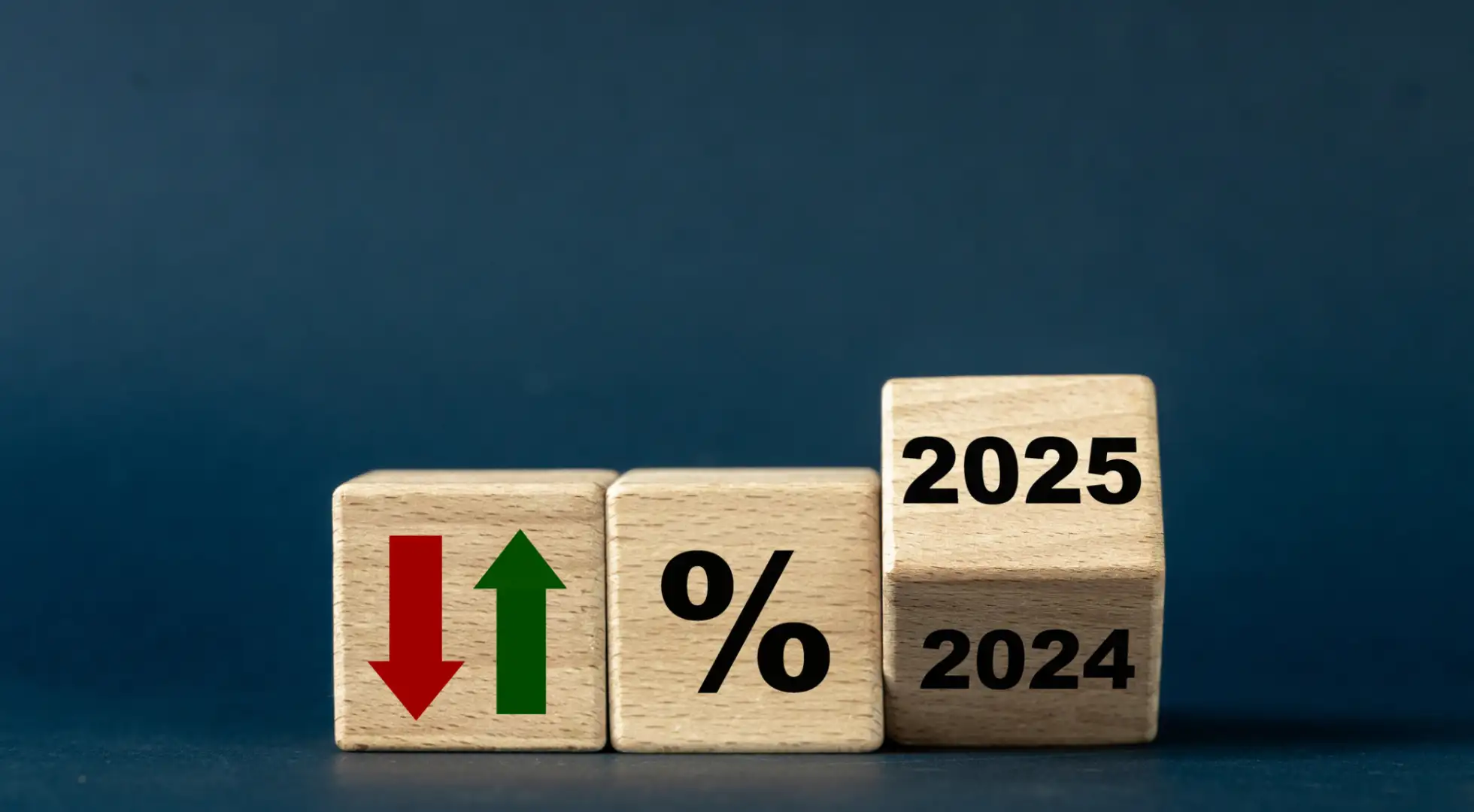2025 Mortgage Rate Forecast: Experts Weigh In

If you’re unsure about where mortgage rates are headed in 2025, you’re in good company.
It seems mortgage rates have everyone guessing after a massive about-face following the September Fed rate cut.
Still, major agencies are forecasting rates below 6% by the end of 2025, at least as of this writing.
So what’s going on?
Will rates drop in 2025? First, let’s examine the rest of 2024.
Will Rates Drop Again in 2024? Or Are We Stuck Near 7%?
So here’s the question on everyone’s mind: Was the recent rate drop a temporary dip, or are we entering another era of higher rates? Why did rates go up after the Fed rate cut in September?
We have to look at 2024 to find out.
In October 2023, the 30-year fixed rate hit a two-decade high of 7.79% before briefly touching 6.08% in September 2024. That’s no sub-three-percent rate, but a welcome reprieve nonetheless. Rates bounced upward again after the Fed’s half-point rate cut decision on Sept. 24, 2024, and kept rising. Will we see low 6s in 2024 again?
“If you're looking at the horizon towards the end of the year, it's likely that we've probably gotten most or all of what we're going to get” in terms of lower rates, said Ralph McLaughlin, senior economist at Realtor.com. “That's probably primarily because the labor market is looking very strong and very healthy, and that's what the Fed is paying attention to,” he said.
“So if the market was already pricing in two [projected rate cuts], but now it looks like we're only going to get one, then the market adjusts, and that's why we saw mortgage rates kind of go up over the last few weeks,” he said.
2025 Rate Predictions: Coasting to About 6%
Most major forecasts put the final rate in the 6% ballpark, with slight variations. Keep in mind, though, that major agencies often update their forecasts based on new information. Don’t be surprised if these agencies change their tune after recent rate increases.
Housing Authority | 30-Year Fixed Rate Forecast |
Fannie Mae | 5.7% |
Freddie Mac | 6.4% |
Mortgage Bankers of America | 5.8% |
National Association of Realtors | 6.0% |
National Association of Homebuilders | 5.9% |
Wells Fargo | 5.9% |
Average | 5.95% |
“Now, on a much longer time horizon, with inflation certainly under control, and the labor market becoming healthy, it is likely the Fed is going to continue to cut,” McLaughlin said. “It’s just a matter of how much, and when.”
Lower rates should help “unlock” homeowners who are reluctant to sell when rates are high. Those sales would open up more supply for buyers, although not enough to keep up with demand.
“The lift will be modest given continued tightness in the existing inventory,” write the researchers from Freddie Mac’s Economic & Housing Research group in its 2024 Outlook report. But until supply meets demand, slipping interest rates will only go so far.
“Really, you have to look at the structural components of the U.S. housing market to look at affordability,” McLaughlin said, “and that is fundamentally, these days, the relative amount of supply compared to demand.” Boomers, for example, own 38% of U.S. homes; whether they sell or hold could have an outsized influence on supply, too.
Still, a thaw is a thaw. “Lower mortgage rates in September helped breathe some life back into the housing market,” writes the EHR group. Continued lower rates could breathe even more into it. The question is whether they’ll keep dropping or not.
Two Factors Influencing Mortgage Rates in 2025
So why did rates jump? Two words: the economy. As Fannie Mae’s economists point out in their October brief, both inflation and the labor market cooled at just the right speed for an economy aiming for its “soft landing.” Americans have more cash in their pockets (or at least are more comfortable with spending), according to Fannie Mae’s ESG group, and the bond market is readjusting to Fed projections.
“Buyers should expect to navigate choppy waters with a ‘2 steps forward, 1.5 steps back’ when it comes to rates,” offered Kyle McCort, loan originator and sales manager with NFM Lending.
1. A Hotter Labor Market Could Mean Higher Rates, So Watch the Jobs Report
If inflation re-accelerates and the labor market heats up, we’ll likely get higher rates, McLaughlin said. If inflation cools and the labor market deteriorates, rates will go lower. “That’s kind of the big-picture framework for how we think about where mortgage rates are going to go,” he said. A gently cooling labor market equals falling rates.
“That's how we can expect whether rates will go up or go down: the direction is going to be based on where you think inflation and the labor market is going to hit,” he said.
Why does a tight labor market drive up rates? Companies have to attract fewer workers with higher wages. They pay for increased costs by raising the prices of goods and services. This is the definition of inflation.
High inflation is bad for mortgage rates. Hence, worse mortgage rates come with a tighter labor market.
2. Geopolitical Events Could Yield Better…Or Worse Rates
What about the big, big picture – the global picture? What are some black-swan events that could turn today’s mortgage rates on their heads? Geopolitical forces like the ongoing wars in Ukraine and the Middle East have that potential. Disruptions in oil supplies or trade, or threats to national security, could force mortgage rates down as the economy takes a hit, McLaughlin said.
“The only fear I have is something happens geopolitically, you know,” said Anthony Grosso, senior loan officer at Green River Capital. “We can never know that. Then it turns and puts [the economy] back on either an inflation or stagflation sort of situation,” he said.
We saw supply chain constraints turn into inflation in 2021 as the economy tried to jump start itself after the pandemic. Oil disruption due to geopolitical conflict could do something similar, since oil is a big part of the price we pay for just about everything.
“All My Locks Are On the Dips”
While we all wish we could predict the unpredictable – “I would love to have that power,” laughs McLaughlin – the truth is that over time, the big-impact events that raise or lower rates tend to balance out with home prices. The trick is to find the window of opportunity before those factors balance out.
Consider the pandemic – there was a period after rates plummeted to historic lows before home prices began to rise. If you got in the market then, you’re probably thanking your lucky stars now – and wondering when you’ll ever feel comfortable enough to sell.
While the factors that led to that particular window of opportunity aren’t likely to happen in tandem again, there will probably be different moments to take advantage of. As a seller or a buyer, you’ll have an easier chance of leaping on them if you have some experts in your corner.
“You have to be really in tune with this stuff,” said Grosso. “Anyone who gets their news from the news, like if you’re talking to someone who does mortgages and they’re just telling you what you heard on TV, you’re not where you need to be,” he said.
For example, “if you look at where I locked [clients’ mortgage rates], all my locks are on the dips,” he said.
Higher rates could mean you could have some room to negotiate with sellers, and that’s where an experienced real estate agent could come in handy.
“If you have to buy at this time, higher rates typically mean less activity,” McCort said. “So leveraging seller concessions vs. negotiating a lower sales price can help you cover costs for a lower rate and keep your payment comfortable,” he said. “This is case by case, so always consult with your Realtor to see if you have any room to negotiate with the seller.”
Watch For Your Window of Opportunity
“If we've learned anything over the last two years, it's the market isn't going to move the way experts think,” said McCort. “In 2023, we had all the major financial institutions saying we'd be back down in the 5's by now, and here we are pushing 7's again after the Fed cut rates,” he said.
“Long-term rates will likely still improve substantially, but it doesn't seem like we're out of the woods yet,” he said. As he points out, “It took us almost two years to get to the conversation of rate cuts, and when the Federal Reserve finally made a move, the market balked.”
The market has a funny way of pricing in consensus – “anything we collectively think as a people,” says Grosso. The market has already considered that eventuality and collectively priced it in.
“Anything the masses think, won't happen,” he said. Timing the market with real estate is like timing the market with stocks – if it were that easy, everyone would do it.
In the meantime, “there's going to be that sweet spot” where mortgage rates come down but before they recapitalize back into home prices, McLaughlin said. “So that can be a nice little window. It may not feel like it at the time, but it certainly would be a nice little window of opportunity,” he said.








